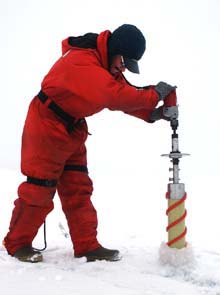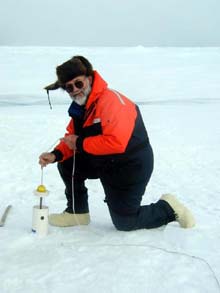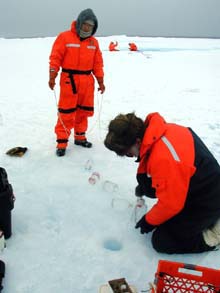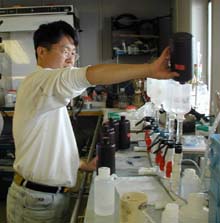
Joe Illasiak, a wildlife observer from the Dept of Fisheries and Oceans Canada, drills through the pack ice. The Sea Ice Ecological Group will analyze the ice core and the Primary Productivity Group will collect water samples from the hole left in the ice. Click image for larger view.

Terry Whitledge from the University of Alaska Fairbanks gingerly lowers the sampler through a hole in the pack ice. Click image for larger view.
Food for the Critters
September 1, 2002
Terry Whitledge
University of Alaska Fairbanks
All animal life in the ocean needs food to grow and reproduce and feed other organisms. The chain of nourishment starts with ultra-tiny, single-celled plants called phytoplankton. The phytoplankton often grow rapidly when sunlight and nutrients are plentiful, but that lasts only a short time in the Arctic. During the summer, daylight hours are long with nearly continuous sunlight that can penetrate the patches of open water. However, ice and snow cover can greatly reduce the quantity of light that reaches the water beneath the ice. During August and September, the ice has melted to its greatest extent for the year. So it is possible to find quite a lot of open water and thinner ice. The melted ice releases freshwater that dilutes the salt and nutrient content of the seawater. As a result, the critical amounts of sunlight and nutrients needed by the phytoplankton are often not available. Thus, they do not grow very fast and little food is available.
Drilling holes through the ice to collect water samples
We can discover the quantity of phytoplankton in the water and their rates of growth by analyzing samples of seawater. The microscopic phytoplankton are suspended in the seawater. The highest concentrations generally are near the surface where the sunshine is most abundant. We must drill a hole through the ice to obtain water samples at various depths below the ice. The ice drill cuts a 4-inch diameter hole through as much as 14 feet of ice. When the drill breaks through the bottom of the ice, water floods the hole to within a few inches of the surface. To collect samples, we lower a water sampler through the hole down to the desired depth. The sampler is a plastic pipe that closes on both ends when a sample is complete. It is common to collect samples a few inches from the bottom edge of the ice down to as much as 100 feet below the ice. It can be difficult to keep your hands warm though, because the seawater is often below 30F (-1.5C) and the cold air and wind exacerbate the situation. Using insulated rubber gloves are the only way to handle the wet bottles and rope after several lowerings.

Scientists lower the sample bottles to measure primary production at various depths. In the background, the scientists from the sea ice ecological group search for life in the ice meltponds. Click image for larger view.

Sang Lee, a graduate student at University of Alaska Fairbanks, filters phytoplankton collected in the water samples. This is the final step in processing the samples in the field. Click image for larger view.
Measuring the growth of plants that are too small to see
When phytoplankton grows, it absorbs the nutrients from the surrounding water. We can add very small amounts of a chemical tracer to the water, which enables us to measure its growth with an electronic instrument. We add a very small amount of chemical to each sample bottle to follow carbon and nitrogen growth simultaneously. The sample bottles are then tied to a rope with a weight at the bottom and lowered to the depth where they were originally collected. Using this technique, the samples are kept at their normal temperature and light for three to six hours. The rope and sample bottles are removed at the end of the incubation period.
The final step in the field process is filtration of the water and phytoplankton through a micropore filter. The phytoplankton particles are retained on the filter, which is then gently dried and analyzed in a mass spectrometer instrument. After analysis of the particles on the filter, we will know the quantity of carbon, nitrogen and chlorophyll pigments contained in the water sample as well as the quantity of carbon and nitrogen that the phytoplankton absorbed during the incubation period.
Why are we doing this?
The Arctic is changing rapidly. Higher temperatures have decreased the amount of ice in the Arctic Ocean over the past 40 years. This has resulted in more open water, especially in coastal areas. The phytoplankton produce the important food for all the animals that live in the Arctic, but we still do not know if the change from a lot of ice cover to mostly open water will provide less food or more food. The phytoplankton in the open water rather than under the ice may be a different variety that is not as nutritious or palatable to organisms. Already, satellite observations have indicated that currents are bringing small plants called coccoliths into the Arctic from the Bering Sea. We do not know if these coccoliths are growing in the Arctic waters, but we hope our measurements will provide data to be compared to future samples.
What have we found thus far?In the field, we can estimate the number of phytoplankton in the water by the brown/green color of the particles on the filters. Using this technique, we found a high concentration of phytoplankton in the water only inches below the ice surface. The concentrations decrease rapidly only a few feet deeper. This decreasing trend continues down to almost 150 feet, where the waters have a different origin.
High concentrations of phytoplankton near the bottom of the ice may indicate that melting water from the ice contains some important nutrients that stimulate phytoplankton growth. Another possibility is that the ice provides a solid cover for the water column, which reduces wind disturbance to the upper layers. This possibility would reduce mixing and allow the plant cells to remain near the surface.
The relatively large concentrations of phytoplankton near the bottom of the ice also indicate that this would be a good location for a grazing animal to find a juicy meal. When we have the final data in our laboratory, we will compare our results with other investigators who are studying animals in the ice and water column.
Sign up for the Ocean Explorer E-mail Update List.


























